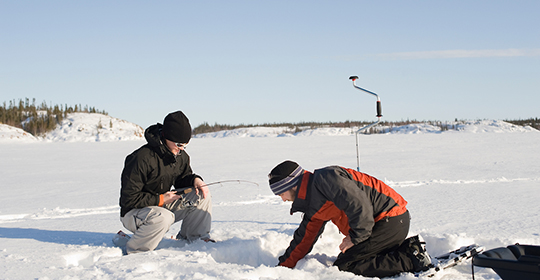Practical Safety Tips for Ice Fishing in March
By Ken Schultz
Mar 07, 2023
This safety-focused advice will put you in good stead for ice fishing in March, with variable weather and ice conditions being the new norm
Often, the latter part of winter in northern locales can offer good ice fishing in March. Ice fishing for walleye in March, for example, is usually considered to be quite productive, as these fish may be concentrated closer to spawning locations. Ice fishing in March for yellow perch, crappies, and sunfish can also be very good.
But this winter I’m hearing a lot about the lack of snow and the lack of lake/pond ice in so many places that used to have both, that ice fishing in March is starting to look dicier, at least with respect to safety. You know that if ski resorts don’t have enough cold weather to even make snow to ski on, then the lakes in those same regions may have open water or such thin ice that you can’t safely go on them with your ice fishing gear, let alone a packed sled or snowmobile.
Certainly, some northern locales have had enough cold weather for thick ice to form on many waters. If, for example, you’re thinking about ice fishing Lake of the Woods in March for walleyes, or possibly Lake Simcoe for lake trout, or any other large body of water that stays frozen for a long time, you’re probably in good shape for some or all of March this year.

While it’s unwise to make universal proclamations any more about ice fishing in March, assuming that you have somewhere to drill a hole, consider this advice:
1. Safety must be a foremost consideration. Note that late-season ice can be weaker than earlier in the season; thickness is always a consideration. To venture on the ice, you need 4 inches for a person walking, 5 to 7 inches for snowmobiles and ATVs, and 8 to 12 inches for cars and light pickup trucks.
2. Ice floes on large lakes can shift with the wind (every year people get stuck on separated floes on Lake Erie), so you must understand and respect the vagaries of the body of water you venture on, and the possible changes in ice conditions.
3. Remember that ice does not necessarily form uniformly on each body of water, so it can be thicker or thinner in some areas than others. Also, places with current can be problematic, as well as areas near bridges, dock pilings, and inlets. Use special caution in such locations.
4. Later in winter, ice near the shore can be more dangerous than offshore, due to warming near the shallow shoreline and the influx of runoff from rain or snow melt, so be careful getting away from the bank.
5. If you’ve ever fallen through the ice, you can appreciate how hard it is to get back onto safe ice, and how helpful it is to have ice-gripping hand picks on a lanyard around your neck. A friend and I fell through an ice-skating pond once as boys, and I wish I’d had such picks, as it was tough to boost ourselves out of the chest-high, muck-bottomed pond with no help. Now imagine doing so when your feet aren’t touching the bottom and the ice is level with your neck, not to mention wearing heavy wet clothes and boots. It seems crazy not to invest in a pair of ice-gripping hand picks, even though you may never need them.









